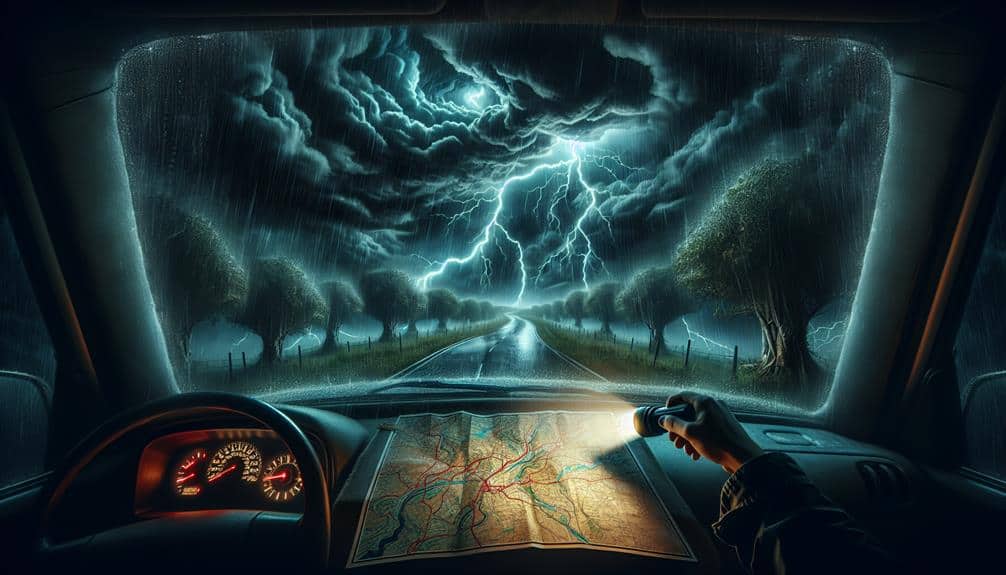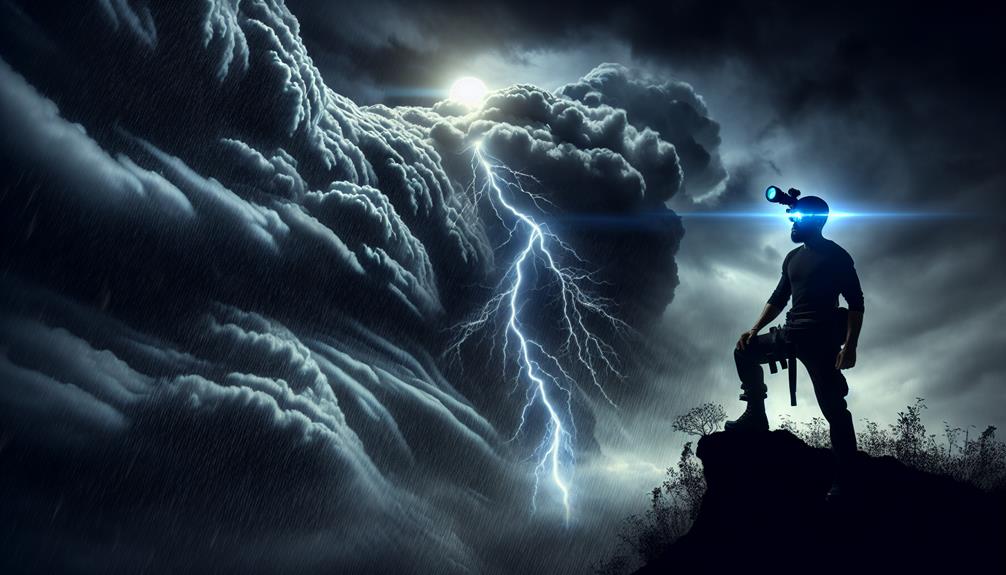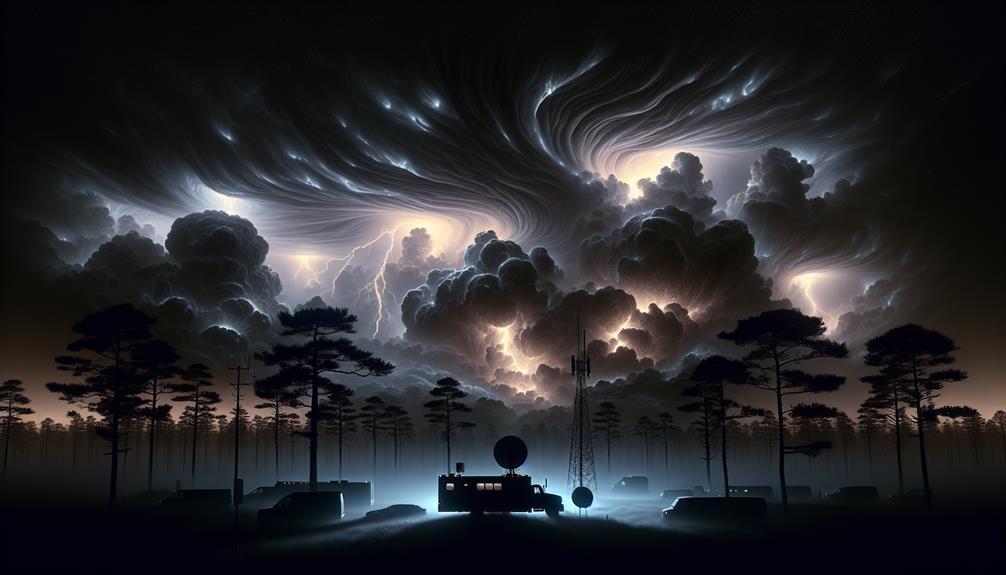We rely on Gen 3 night-vision gear and high-lumen, water-resistant LED flashlights, at least 1,000 lumens, to navigate storm areas. Real-time Doppler and dual-polarization radar apps, like RadarScope, provide wind patterns and storm differentiation. We meticulously plan routes with topographic maps and prioritize safety with emergency shelters and robust communication via radio and GPS. Understanding storm behavior at night involves analyzing radar data, lightning frequency, and employing night vision tools for increased visibility. For those intrigued by the nuances of nighttime storm interception, there's a lot more to explore.
Key Points
- Utilize Gen 3 night-vision gear for accurate storm structure and hazard identification.
- Wear high-visibility reflective attire to enhance detection distances in low-light conditions.
- Use portable, water-resistant LED flashlights with a minimum of 1,000 lumens for essential tasks.
- Access real-time radar data via reliable apps like RadarScope for high-resolution storm tracking.
Equip Proper Night Gear
To effectively intercept severe thunderstorms at night, we must equip ourselves with high-visibility reflective attire, night-vision gear, and dependable portable illumination. Reflective clothing increases our visibility to both fellow storm chasers and other motorists, reducing the risk of accidents. A 2019 study found that reflective materials enhance detection distances by up to 300 meters. This is vital when traveling through heavy rain or hail in low-light conditions.
Night-vision gear is another indispensable tool. They amplify ambient light and provide us with the capability to see through the darkness, identifying storm structures and potential hazards. Modern night-vision gear, such as the Gen 3 models, offer enhanced resolution and longer battery life, which is essential during extended night operations. Data from field tests show that night-vision gear can improve detection accuracy by 70%, allowing us to make timely decisions.
Portable illumination, including high-lumen LED flashlights and headlamps, ensures we can perform essential tasks such as setting up equipment or reading maps. These lights should be water-resistant and have a minimum output of 1,000 lumens for peak performance.
This combination of reflective attire, night-vision gear, and dependable lighting ensures we stay safe and effective during our nighttime storm intercepts.
Use Reliable Weather Sources
To guarantee we stay ahead of severe thunderstorms at night, we must use reliable weather sources.
Accessing real-time radar, utilizing trustworthy weather apps, and consulting expert meteorologist insights will provide us with accurate, up-to-the-minute information.
This data-driven approach enhances our ability to make informed decisions and maintain safety.
Real-Time Radar Access
Accurate real-time radar access from dependable weather sources is vital for effectively intercepting severe thunderstorms at night. Radar precision is paramount when night visibility is compromised, making it essential to rely on precise data. We need high-resolution radar imagery to identify storm structures, rotation signatures, and potential hail cores. This level of detail enables us to make informed decisions swiftly.
By leveraging Doppler radar technology, we gain insights into wind patterns, precipitation intensity, and storm cell movement. This information is vital for positioning ourselves safely while maintaining the flexibility to adapt to rapidly changing conditions. Real-time updates guarantee that we aren't caught off-guard by sudden developments, enhancing both our safety and effectiveness.
Access to dual-polarization radar adds another layer of precision. This technology differentiates between rain, hail, and debris, providing a clearer picture of what we're facing. Night visibility challenges are mitigated through these advanced radar systems, allowing us to navigate storms with confidence.
Reliable sources like the National Weather Service or other trusted meteorological agencies offer the most accurate radar data, ensuring we've the best possible information at our fingertips. In the pursuit of freedom, precise and timely radar access is our most valuable tool.
Trustworthy Weather Apps
Leveraging reliable weather apps enhances our ability to access dependable, real-time data from trustworthy sources, complementing the precision of radar technology.
We need tools that provide detailed weather radar imagery and immediate lightning alerts to stay ahead of severe storms, especially at night. Apps like RadarScope and MyRadar offer high-resolution, looped radar animations, which are essential for tracking storm movement and intensity with pinpoint accuracy.
Moreover, these apps often integrate National Weather Service (NWS) alerts, ensuring we receive authoritative information. Lightning alerts are particularly vital; they offer immediate notifications of electrical activity, allowing us to gauge storm proximity and potential danger zones.
Apps like WeatherBug provide real-time lightning detection within a specified radius, giving us the lead time we need to make informed decisions.
Expert Meteorologist Insights
We consistently rely on expert meteorologist insights to interpret complex weather data and provide actionable guidance for dealing with severe nighttime thunderstorms. These professionals utilize advanced storm tracking technology and satellite imagery to enhance nighttime visibility, enabling us to make informed decisions. Their expertise is pivotal in developing accurate safety protocols and ensuring effective emergency communication.
Meteorologists offer several vital insights:
- Real-time Radar Data: Continuous monitoring of storm movements helps us anticipate changes and respond promptly.
- Satellite Imagery: High-resolution images improve our understanding of storm structures, essential for precise tracking.
- Model Predictions: Numerical weather prediction models provide future scenarios, aiding in proactive planning.
- Severe Weather Alerts: Timely notifications keep us informed about potential risks, allowing for quick action.
Plan Your Route Carefully

To maximize safety and efficiency, we must carefully study weather patterns using the latest meteorological data.
It's important that we use reliable equipment, including GPS systems and weather radios, to track storm movements.
Additionally, identifying and planning for safe zones guarantees we've secure locations to retreat if conditions worsen.
Study Weather Patterns
Careful analysis of meteorological data, including radar and satellite imagery, allows us to chart a precise route for intercepting severe thunderstorms at night. By studying weather patterns, we can predict cloud formations and lightning activity, which are key indicators of storm intensity. We observe wind patterns and temperature fluctuations to understand storm development and movement.
When planning our route, we consider:
- Cloud Formations: Identifying cumulonimbus clouds helps us locate potential strong thunderstorms.
- Lightning Detection: Monitoring lightning strikes provides real-time data on storm intensity and location.
- Wind Patterns: Analyzing wind shear and jet streams assists in predicting storm paths and potential severity.
- Temperature Fluctuations: Sharp changes in temperature indicate atmospheric instability, essential for storm formation.
Use Reliable Equipment
Armed with advanced meteorological data, let's now focus on making sure our gear is reliable and carefully plan our route to intercept severe thunderstorms effectively at night.
Night vision technology is indispensable for nocturnal storm chasing. We should opt for high-quality night vision goggles or thermal imaging cameras, which offer superior visibility under low-light conditions. These devices help us navigate treacherous terrains and identify storm structures even in the darkest hours.
Equipment maintenance is paramount. We must regularly inspect and calibrate our meteorological instruments, such as anemometers and barometers, to guarantee accurate data collection. It's vital to carry backup batteries and power sources for all electronic devices to avoid any unexpected failures during critical moments.
Route planning should be data-driven and adapt to real-time weather updates. Using reliable GPS systems integrated with live weather feeds allows us to make informed decisions quickly. We can pre-load multiple potential routes to adapt our trajectory based on storm movement. This flexibility is essential for maintaining proximity to the storm while ensuring our safety.
Identify Safe Zones
Identifying safe zones is critical; we'll rely on updated meteorological data and topographic maps to pinpoint areas less likely to experience severe impacts. By analyzing real-time weather data, we can avoid regions with high lightning risks and visibility challenges.
Establishing a route that incorporates emergency shelter locations and guarantees vehicle safety is paramount.
Let's consider some key strategies:
- Consult Real-Time Weather Updates: We need to monitor radar and satellite feeds continuously to stay ahead of the storm's path.
- Use Topographic Maps: These maps help us identify lower-risk areas, such as valleys, which might offer some natural protection.
- Plan Emergency Shelters: Know the locations of sturdy buildings or designated storm shelters along our route.
- Maintain Vehicle Safety: Our vehicles should be parked in a way that allows for quick evacuation if necessary, and away from trees or power lines.
We'll stay vigilant, making quick decisions based on the latest data to ensure our route maintains the highest safety standards.
Freedom to chase storms comes with the responsibility of thorough planning and risk assessment.
Prioritize Safety Precautions
We must strictly adhere to established safety protocols to ensure our well-being while intercepting severe thunderstorms at night. First, let's map out emergency shelters and evacuation routes in advance. This preparation guarantees that we can swiftly relocate to safer areas if conditions deteriorate. We should identify locations such as sturdy buildings or designated storm shelters that can offer protection.
Next, we need to address nighttime visibility. Reduced visibility significantly heightens storm hazards, making it essential to maintain a heightened awareness of our surroundings. Using reliable lighting equipment and keeping our vehicle's headlights and taillights in best condition can mitigate some of these risks.
Considering storm hazards, it's important to recognize that flash flooding, lightning, and high winds pose significant dangers. We should consistently monitor weather updates through reliable sources, such as NOAA Weather Radio or specialized weather apps, to stay informed about any sudden changes in storm intensity or trajectory.
Lastly, our vehicles should be equipped with emergency kits containing essentials like first aid supplies, water, non-perishable food, and tools for basic repairs. By integrating these measures, we can navigate the challenges of nighttime storm interception safely, preserving our freedom to explore and document severe weather phenomena.
Leverage Night Vision Tools

Maximize our nighttime storm-chasing capabilities by integrating advanced night vision tools like thermal imaging cameras and night-vision goggles. These technologies offer significant safety benefits and enhance our ability to track storms effectively. Night vision technology allows us to see through the darkness, making it easier to monitor storm developments and avoid hazards.
Utilizing thermal imaging cameras, we can detect temperature variations, which are essential for identifying storm systems and their intensity.
Here's how leveraging night vision tools can enhance our storm-chasing experience:
- Increased Visibility: Night vision technology helps us see beyond the limitations of standard headlights, providing a clearer view of potential tornadoes and other severe weather phenomena.
- Improved Safety: By enhancing visibility, we can navigate treacherous terrain more safely, reducing the risk of accidents.
- Efficient Storm Tracking: Thermal imaging cameras allow us to pinpoint the most active parts of a storm, enabling more accurate tracking.
- Data Collection: Night vision tools help us gather critical data on storm behavior, contributing to better forecasting and research.
Incorporating night vision technology is essential for ensuring our safety and effectiveness during nighttime storm chases.
Communicate With Fellow Chasers
Effective communication with fellow chasers is crucial for coordinating positions, sharing real-time data, and maximizing collective safety during nighttime storm intercepts. Utilizing a combination of radio frequencies, mobile apps, and GPS tracking, we can maintain constant contact and adjust strategies dynamically. When visibility is low, exchanging precise geolocation data becomes crucial.
For optimal chaser safety, we must establish a primary and secondary communication channel. This redundancy guarantees that even if one channel fails, we can still relay critical information. Nighttime strategies should include predefined check-in intervals, where we update each other on weather conditions, road status, and any hazards encountered.
Leveraging platforms like Spotter Network, we can share real-time updates on storm movement and intensity. Additionally, having a dedicated team member focused solely on monitoring these communications can free others to concentrate on navigation and data collection.
During the night, the margin for error narrows. Clear, concise communication minimizes risks and maximizes efficiency. By adopting these techniques, we enhance our collective ability to make informed decisions quickly, maximizing our mission's success and our personal safety.
Let's stay connected, vigilant, and ready to adapt as we pursue these powerful storms.
Understand Storm Behavior at Night

Understanding the unique characteristics of storm behavior at night is essential for accurate prediction and safe navigation during nocturnal intercepts. Night visibility is notably reduced, which challenges even the most experienced storm chasers. We must adapt our storm tracking techniques to compensate for this limitation.
Nighttime storms often exhibit different dynamics compared to their daytime counterparts. For instance, nocturnal convection can occur due to the stabilization of the lower atmosphere, while upper-level disturbances provide the necessary lift.
Here are key factors to keep in mind when intercepting storms at night:
- Radar Utilization: Rely heavily on radar data, as visual cues are minimized.
- Lightning Frequency: Monitor lightning activity, which can illuminate storm structures.
- Surface Observations: Use surface weather stations to track temperature and humidity changes.
- Thermodynamic Profiles: Analyze upper-air soundings for indications of instability.
Staying updated on these elements allows us to make informed decisions, enhancing both our safety and the quality of our storm data.
Frequently Asked Questions
How Can I Differentiate Between Thunderstorm Sounds and Other Night Noises?
To differentiate night sounds, we should focus on thunderstorm identification by analyzing sound patterns. Thunderclaps are low-frequency, rolling sounds, whereas typical night noises are higher-pitched and shorter. Precise observation will improve our accuracy.
What Are the Best Smartphone Apps for Tracking Nighttime Thunderstorms?
We grasp skepticism about app accuracy, but our preferred choice is RadarScope for precise weather radar and alerts. Storm tracking with MyRadar guarantees safety, offering real-time updates. These apps offer freedom to stay informed and protected.
How Can I Stay Alert and Focused During Late-Night Storm Chasing?
To stay awake and maintain night vision during storm chasing, we rely on caffeine, scheduled breaks, and red LED lights. Data shows red light preserves night vision, essential for monitoring radar and traveling safely.
Are There Any Specific Signs of Lightning Activity to Watch for at Night?
In the dance of the storm, lightning flickers signal its rhythm. We watch nighttime radar for patterns, listen for distant rumbles, and track sky flashes. These indicators help us anticipate and navigate through the tempest's fury safely.
What Should I Do if I Encounter Unexpected Road Closures During a Night Chase?
When we encounter unexpected road closures, we should immediately consult our GPS for road detours. We must also have emergency plans in place, ensuring alternative routes and safe locations are identified beforehand to maintain our mobility.


